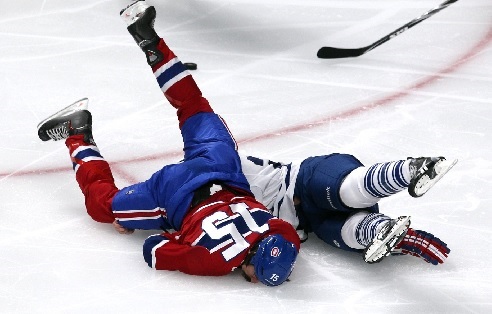Why Fighting Needs To Go In The NHL

The infamous line brawl of 2013-14 between the Vancouver Canucks and Calgary Flames. The all-out brawl between the Anaheim Ducks and San Jose Sharks from Oct. 26 this season. Though they are fewer in number compared to decades past, brawls and fights in general still find their way into games in 2014.
Yes, fighting is as old as the game itself, which is why it’s so hard for hockey purists – from fans to those in the game itself – to let it go. But the sad truth is fighting has run its course in the NHL. With head injuries on the rise and the presence of one-dimensional fighters on the down swing, getting rid of fighting seems to be the only logical decision.
The three North American counterparts to the NHL – the NBA, NFL and MLB – each don’t allow fighting, and their popularity isn’t suffering any because of it. Anyone who doubts that needn’t look much further than the rich TV contracts each league has signed in recent years.
Some would argue fighting is part of the draw to a hockey game, but ask fans of any team around the league (okay, maybe not the Florida Panthers) what it is that brings them to games. Are they there for the fighting or for the product on the ice? I enjoy a good scrap as much as the next fan, but I don’t attend games looking for fisticuffs.
Let’s also get another thing straight: it’s impossible to ban fighting. No form of punishment can fully prevent a player from fighting. But they can take the example of the other three leagues by doing more than just giving a five minute slap on the wrist for repeatedly punching another player in the face.
Any perceived energy boost that comes from a scrap can be gained from a good, hard hit. But therein lays the issue with the culture of the game in 2014: it’s almost impossible to throw that type of hit without paying the price. And what if a player happens to get knocked out? How quickly the mood can change.
Plus, all that face punching leads to another issue: brain health. For a league that constantly vocalizes its desire to improve player safety, turning a blind eye to all of the readily available information on repeated head trauma is more than a little contradictory to its message. And it’s a lot easier to stop two players from punching each other than it is to prevent head shots.
To put it in terms the NHL cares about, the bottom line stands to face more negative effects through inaction than action. The league can either take the chance on losing money from a few hundred to a few thousand fans by removing fighting, or risk facing expensive lawsuits down the road from former players for being neglectful of their health.
Let’s not be naïve – in pro sports, money talks.
So how do you fix the problem? A direct solution is to increase the severity with which fighting is punished, both in-game and through supplemental discipline. Ejecting players after a fight or implementing a gradated scale for suspending players – one game for three fights, two games for six fights, three for nine, etc. – is one way of doing this.
The indirect method would be for the NHL’s Department of Player Safety to hand out stiffer punishments, thus eliminating the need for players to police the game themselves – a strategy that is already failing. If players know a head shot, a spear, or similar action will be punished with due severity, they will be less likely to take matters into their own hands (fists, if you will).
Regardless of whether or not the league actually takes action, there’s no question fighting needs to be shown the door sooner rather than later. Any perceived benefit of fighting can either be replaced by the existing physical nature of the game or is minimal enough that it won’t be missed anyway.
It’s a sobering thought, but the next time this debate pops up the mood could be a bit more somber.


